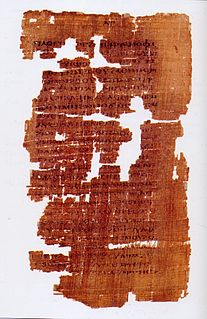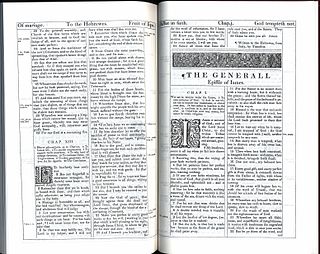
Barnabas, born Joseph (Ἰωσήφ) or Joses (Ἰωσής), was according to tradition an early Christian, one of the prominent Christian disciples in Jerusalem. According to Acts 4:36, Barnabas was a Cypriot Jew. Named an apostle in Acts 14:14, he and Paul the Apostle undertook missionary journeys together and defended Gentile converts against the Judaizers. They traveled together making more converts, and participated in the Council of Jerusalem. Barnabas and Paul successfully evangelized among the "God-fearing" Gentiles who attended synagogues in various Hellenized cities of Anatolia.

The Epistle of Jude is the penultimate book of the New Testament as well as the Christian Bible. It is traditionally attributed to Jude the Apostle, brother of James the Just, and thus possibly brother of Jesus as well.
Pope Linus was the bishop of Rome from c. AD 67 to his death. As with all the early popes, he was later canonized.

The Second Epistle of Peter is a book of the New Testament of the Bible, traditionally held to have been written by the Apostle Peter. Most critical biblical scholars consider the epistle pseudepigraphical.

Pope Clement I, also known as Saint Clement of Rome, is listed by Irenaeus and Tertullian as the bishop of Rome, holding office from 88 AD to his death in 99 AD. He is considered to be the first Apostolic Father of the Church, one of the three chief ones together with Polycarp and Ignatius of Antioch.

An epistle is a writing directed or sent to a person or group of people, usually an elegant and formal didactic letter. The epistle genre of letter-writing was common in ancient Egypt as part of the scribal-school writing curriculum. The letters in the New Testament from Apostles to Christians are usually referred to as epistles. Those traditionally attributed to Paul are known as Pauline epistles and the others as catholic epistles.

The shovelers or shovellers are four species of dabbling ducks with long, broad spatula-shaped beaks:

The Epistle of Barnabas is a Greek epistle written between AD 70 and 132. The complete text is preserved in the 4th-century Codex Sinaiticus, where it appears immediately after the New Testament and before the Shepherd of Hermas. For several centuries it was one of the "antilegomena" ("disputed") writings that some Christians looked on as sacred scripture, while others excluded them. Eusebius of Caesarea classified it as such. It is mentioned in a perhaps third-century list in the sixth-century Codex Claromontanus and in the later Stichometry of Nicephorus appended to the ninth-century Chronography of Nikephoros I of Constantinople. Some early Fathers of the Church ascribed it to the Barnabas who is mentioned in the Acts of the Apostles, but it is now generally attributed to an otherwise unknown early Christian teacher. It is distinct from the Gospel of Barnabas.
The Apostolic Fathers were core Christian theologians among the Church Fathers who lived in the 1st and 2nd centuries AD, who are believed to have personally known some of the Twelve Apostles, or to have been significantly influenced by them. Their writings, though widely circulated in Early Christianity, were not included in the canon of the New Testament. Many of the writings derive from the same time period and geographical location as other works of early Christian literature which came to be part of the New Testament. Some of the writings found among the Apostolic Fathers appear to have been as highly regarded as some of the writings which became the New Testament.

The New Testament apocrypha are a number of writings by early Christians that give accounts of Jesus and his teachings, the nature of God, or the teachings of his apostles and of their lives. Some of these writings have been cited as scripture by early Christians, but since the fifth century a widespread consensus has emerged limiting the New Testament to the 27 books of the modern canon. Roman Catholic, Eastern Orthodox, and Protestant churches generally do not view these New Testament apocrypha as part of the Bible.
Clement or Clément may refer to:

The Pauline epistles are the fourteen books in the New Testament traditionally attributed to Paul the Apostle.

The First Epistle of Clement is a letter addressed to the Christians in the city of Corinth. Based on internal evidence some scholars say the letter was composed some time before AD 70, but the common time given for the epistle's composition is at the end of the reign of Domitian. It ranks with Didache as one of the earliest, if not the earliest, of extant Christian documents outside the traditional New Testament canon. As the name suggests, a Second Epistle of Clement is known, but this is a later work by a different author. Part of the Apostolic Fathers collection, 1 and 2 Clement are not usually considered to be part of the canonical New Testament.

The Second Epistle of Clement, often referred to as 2 Clement, is an early Christian writing. It was at possibly at one point considered canon by the Coptic Orthodox Church.
John Clement was an English Roman Catholic physician and humanist. He was tutor to Thomas More's children, and became President of the College of Physicians.

The Epistle to the Hebrews of the Christian Bible is one of the New Testament books whose canonicity was disputed. Traditionally, Paul the Apostle was thought to be the author. However, since the third century this has been questioned, and the consensus among most modern scholars is that the author is unknown.

The canon of the New Testament is the set of books many modern Christians regard as divinely inspired and constituting the New Testament of the Christian Bible. For historical Christians, canonization was based on whether the material was from authors socially approximate to the apostles and not based solely on divine inspiration – however, many modern scholars recognize that the New Testament texts were not written by apostles. For most, it is an agreed-upon list of 27 books that includes the canonical Gospels, Acts, letters attributed to various apostles, and Revelation, though there are many textual variations. The books of the canon of the New Testament were written before 120 AD. Although the list of what books constituted the canon differed among the hundreds of churches in antiquity, according to ancient church historian Eusebius there was a consensus that the same 27 books constituting the canon today were the same 27 books generally recognized in the first century.

Saint Peter, also known as Peter the Apostle, Peter the Rock, Simon Peter, Simeon, Simon or Cephas, was one of the Twelve Apostles of Jesus Christ, and one of the first leaders of the early Church. Based on contemporary historical data, his papacy is estimated to have spanned from AD 30 to his death, which would make him the longest-reigning pope, at anywhere from 34 to 38 years; however, the length of his reign was never verified.
Gaius is the Greek spelling for the male Roman name Caius, a figure in the New Testament of the Bible.
- A Christian, Gaius is mentioned in Macedonia as a traveling companion of Paul, along with Aristarchus.
- One chapter later, Gaius who has a residence in Derbe is named as one of Paul's seven traveling companions who waited for him at Troas.
- Gaius is mentioned as having a residence in Corinth as being one of only a few people there who were baptised by Paul, who founded the Church in that city.
- Gaius is referred to in a final greeting portion of the Epistle to the Romans as Paul's "host" and also host of the whole church, in whatever city Paul is writing from at the time. In all likelihood, this was Corinth.
- Lastly, Gaius of Ephesus to whom the third Epistle of John is addressed. He may be Gaius mentioned in any of the other contexts.
In Greek mythology, Laodice may refer to the following figures:









